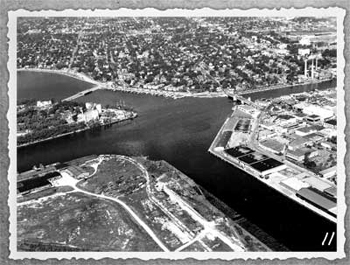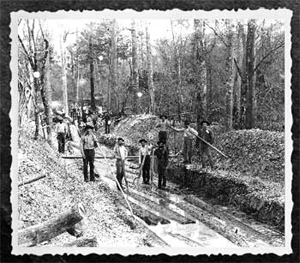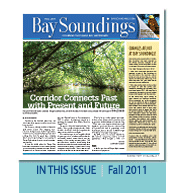 |
||||||||

Weaving the Past with the Present:
A trip down the Hillsborough River
Hillsborough River Guidebook, Kevin M. McCarthy, 2011, Pineapple Press
Reviewed by Suzanne Cooper, principal planner, Tampa Bay Regional Planning Council
Calling Kevin McCarthy's latest offering a "guidebook" doesn't begin to cover the scope of this wonderfully informative view of the Hillsborough River. Of course, it's a great guide to take if you're planning a trip down the historical waterway, but it's so much more than that.

Photo courtesy Florida State Archives
A 1956 aerial view of downtown Tampa taken from Davis Islands. The hospital is in the lower center, Harbour Island is to the right.
Dr. McCarthy details Florida's geologic evolution, early peoples, and its struggles with the first carpetbaggers in an entertaining format that doesn't come close to anything like a textbook. He mixes the ancient history with recent news to reveal the substance of what we see today across our region – it makes me yearn to pull out a kayak and visit those places again.
But the book also will appeal to people who would never even consider actually venturing into an alligator haven. Each of nine river segments between the Green Swamp and Hillsborough Bay is described by water and by land in a very creative way. The many, many photographs – dating from 1885 to the present – illustrate how far our area has come in terms of technology, transportation and urbanization. It is amazing to see aerial views of downtown Tampa, Davis Islands and what is now Harbour Island when industrial development dominated the waterfront and street cars were commonly used. Pictures of logging trains hauling behemoth tree trunks out of the landscape remind us that it wasn't too long ago that this region was wild and unrestrained.
Archaeological records indicate that humans made their way to this area 12,000 to 15,000 years ago. In 1528, Spanish explorer Panfilo de Narvaez landed near Tampa Bay and found the Tocobaga people established in the area. They called the river Locksa apopka – A Place for Eating Acorns. In 1539 Hernando de Soto, another Spaniard, landed at what was probably the Hillsborough River and had a lasting impact on the area. By the early 18th century, disease and slavery had nearly eliminated the Tocobaga people.
By 1772, a map drawn and sent to English Earl of Hillsborough, Governor of West Florida, showed the river named as the Hillsborough. Modern occupation began in earnest in the early 19th century and hasn't slowed since. The guidebook has pictures of drawings of native-explorer conflicts and photos of some of the early bridges across the river – wide enough for one horse-drawn cart!
The river has been flowing for about 27,000 years. It rises from the Green Swamp in northwestern Polk and Pasco counties, sharing headwaters with the Withlacoochee River, then meanders as a wooded wetland until it flows through Crystal Springs and various tributaries to form a major river. Its headwaters were ignored during the frenzy of swamp-clearing and land-draining activity that dramatically changed the Everglades, Kissimmee River valley and other notable Florida watersheds. Even today, it only has one dam, near Rowlette Park, which forms the 1,300-acre reservoir that supplies the City of Tampa's drinking water.

Photo courtesy Florida State Archives
The river was a popular destination for canoeists as far back as the early twentieth century.
The river's early name – A Place for Eating Acorns – speaks to the abundant oak hammocks and swamps that still border much of the upper river. Much of the rich pine flatwoods that covered the uplands were cleared for cattle ranching in the early 20th century, but large parcels have since been reforested. State and regional agencies own or hold easements on large tracts that are used for groundwater protection and flood control, ensuring that the headwaters will retain their primary function.
At the same time, the lands are accessible to the public -- a real bonus in our urbanized landscape. The guidebook has information on how to access these lands, where to rent a canoe or kayak, and what level of paddling/boating expertise is best to enjoy each of the upper stretches.
Along the river, McCarthy describes the river in terms that draw his readers to seek these same experiences. For example, the section around Trout Creek Park has "the fattest gators on the whole river." And although each stretch of the river is separated into "by water..." and "by land..." subchapters, these lines are quite blurred and are interspersed with history and current events about the local area, the extended area surrounding it, and more. The information flows like a conversation – meandering like the river into related topics and then back to the main point enriched by the diversion.
Dr. McCarthy's references to key people, past and present, and to other publications reminds us just how rich our history is, how many have been inspired to write about it and how many river advocates are still in our midst. He even quotes articles from our own Bay Soundings! The Appendices provide information for boaters, and places to visit, stay and eat on the land side; and the Further Reading section is a valuable listing of books, articles and more that will send you in search of more knowledge about the river and the region.

Photo courtesy Florida State Archives
Lumber harvested from the upper reaches of the river was floated down to sawmills in Tampa as early as the 1850s.
As you can tell, I thoroughly enjoyed this little book, and I'm looking forward to reading more of Dr. McCarthy's work, including guides to the St. Johns and Suwannee rivers which are already available and a new book on the Caloosahatchee that will be published in January 2012. I think I can learn a lot about those rivers, those parts of Florida, and the people who are and have been involved with those rivers. I expect I'll be itching to visit those rivers, too.
About the author: Dr. McCarthy is professor emeritus of English and Florida Studies at the University of Florida where he taught for 33 years. He has written over 50 books on such diverse topics as Aviation in Florida, Lighthouses of Ireland, Florida Outhouses: An Ode to the Shack in the Back, Twenty Florida Pirates, and many, many more on Florida subjects, and has been published in numerous magazines and journals of all sorts. Check out his website at www.kevinmccarthy.us or visit www.pineapplepress.com for a more complete list of his published works.
